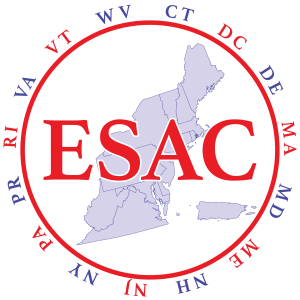Rhode Island
ESAC 2024
Rhode Island
Rhode Island: State of the State
ESAC Rhode Island State Report
The Apprenticeship Office is part of the Rhode Island Department of Labor and Training’s (DLT) Division of Professional Regulation in Cranston, Rhode Island. The Apprenticeship Office has 2.5 FTE ₋ state director, Apprenticeship and Training Representative (ATR), and part time Implementation Aide. Through the US Department of Labor State Apprenticeship Expansion Formula (SAEF) and State Apprenticeship Expansion, Equity, and Innovation (SAEEI) grants, DLT funds a full time Apprenticeship Liaison in the Division of Workforce Development and a team at not-for-profit organization Building Futures. Building Futures is in its seventh year as the state’s apprenticeship intermediary.
Rhode Island has multiple initiatives aimed at 1) program quality and 2) equity and inclusion. Critical to both these objectives is our work to measure and improve license attainment rates in the licensed trades. Observing that the gap between apprenticeship completion and license test scheduling averaged six months, we worked closely with the Division of Professional Regulation’s trade licensing arm to streamline the process. For relevant trades, signing up for a required license exam is now seamlessly integrated into the apprenticeship completion process. Rhode Island has also instituted a “testing card” system whereby completed apprentices receive a short-window to test. The Apprenticeship Office continues communications with major education providers to confirm whether their students are registered apprentices and to provide them feedback on license exam pass rates.
Pre-apprenticeship programming is the most effective strategy for promoting diversity and equity in registered apprenticeship. Rhode Island’s process for certifying pre-apprenticeship programs has been in place for over a year. In order to be certified as a pre-apprenticeship, programs must have established a relationship with at least one registered apprenticeship sponsor with the aim of placing participants in employment therein upon program completion. We are committed to tracking pre-apprenticeship participation with minimal burdens on the Apprenticeship Office. Our solution is to work with pre-apprenticeship providers and partner sponsors to make sure participation in pre-apprenticeship is record in RAPIDS upon registration.
Presently there are pre-apprenticeship programs operating in landscaping, community health work, childcare, and the building trades. In the building trades, all pre-apprenticeships are implementing the North American Building Trades Unions’ Multi‐craft Core Curriculum. This year, Building Futures expanded its nationally-recognized construction pre-apprenticeship by implementing an apprenticeship readiness program “behind the walls” at the Rhode Island Department of Corrections’ men’s minimum security facility. The first program of its kind in Rhode Island, “Bridge to Opportunity” is slated to expand to medium security and women’s facilities in the coming year.
Apprenticeship Statistics (Year 2023)
- 2309 Active Apprentices: 1970 in the building trades and 339 in non-trade programs
- 538 Active Sponsors: 501 in building trades and 37 in non-trade programs
- 947 New Apprentices started: 768 in the building trades and 179 in non-trade programs
- 432 Apprentices completed
- 50 New Sponsors registered
State Apprenticeship Council
The 11-member Rhode Island Apprenticeship Council meets 10 times a year. The Departments of Education and Labor & Training have permanent ex-officio seats. The Council includes building trade as well as non-trade employers. The State Apprenticeship Council reviews new programs and makes a recommendation to the DLT Apprenticeship Office as to whether they merit approval. The highly engaged Council has been key to driving continuous improvement.
Workforce Partnerships
The DLT’s Apprenticeship Liaison continues to promote WIOA supports to employers and stands by them each step of the process. Desk references and policies have been updated to address on-the-ground realities of making these services work for apprenticeship.
A total of thirty-eight (38) Registered Apprenticeship Programs (RAPs) have been added to the Eligible Training Provider List (ETPL), including Rhode Island’s first cybersecurity RAP. Workforce System Apprentice Liaison met with American Job Center coaches to review procedures for connecting job seekers with apprenticeship and qualifying apprentices for WIOA resources.
In July 2023, Governor McKee signed a bill into law mandating that public postsecondary institutions to identify degrees achievable through apprenticeship and establish corresponding pathways. This quarter, Building Futures participated in conversations with postsecondary institutions regarding the establishment of these pathways.
In collaboration with DLT’s Workforce Development Division, the Apprenticeship Office and Building Futures analyzed co-enrollment between Registered Apprenticeship and WIOA. The team is working with this data to learn how to capture more of our co-enrollment. The Workforce Development Division of DLT has chosen to purchase software from GeoSol to connect RAPIDS data to EmployRI, our WIOA reporting system.
Legislative Issues
There are bills in the legislature to establish apprenticeship utilization requirements for public school construction. Bills have been introduced to amend the state’s apprenticeship laws to make them more consistent with applicable federal regulations and make said laws more comprehendible and consistent with each other.
Bills have also been introduced to support a registered apprenticeship pathway to licensure for opticians.
Budget
Core funding and FTE for the Apprenticeship office is stable, supplemented by two USDOL grants State Apprenticeship Expansion Formula (SAEF) and State Apprenticeship Expansion, Equity, and Innovation (SAEEI).

ESAC 2024
Puerto Rico
May 6 – 9, 2024
About ESAC
The respective state sponsors in the form of an ESAC Planning Committee are ad hoc and exist to design the annual conference for that particular state in that particular year.
CONTACT
Eastern Seaboard Apprenticeship Conference
28 Pelham Street
Newport, RI 02840
(401) 847-7666
newportevents1@gmail.com